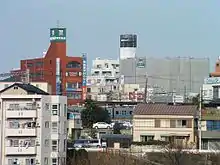Sōbudai-mae Station
Sōbudai-mae Station (相武台前駅, Sōbudai-mae-eki) is a railway station on the Odakyu Odawara Line in Zama, Kanagawa, Japan, operated by the private railway operator Odakyu Electric Railway.
 Sōbudai-mae Station 相武台前駅 | ||||||||||||||||||||
|---|---|---|---|---|---|---|---|---|---|---|---|---|---|---|---|---|---|---|---|---|
 South Exit of Sōbudai-mae Station | ||||||||||||||||||||
| Location | 1-4759 Sōbudai, Zama, Kanagawa (神奈川県座間市相武台1-4759) Japan | |||||||||||||||||||
| Operated by | Odakyu Electric Railway | |||||||||||||||||||
| Line(s) | Odakyu Odawara Line | |||||||||||||||||||
| Connections |
| |||||||||||||||||||
| History | ||||||||||||||||||||
| Opened | 1927 | |||||||||||||||||||
| Previous names | Zama; Shikan-Gakkō-mae (until 1941) | |||||||||||||||||||
| Passengers | ||||||||||||||||||||
| FY2011 | 37,931 daily | |||||||||||||||||||
| Services | ||||||||||||||||||||
| ||||||||||||||||||||
Lines
Sōbudai-mae Station is served by Odakyu Odawara Line, and is located 36.9 km from the line's Tokyo terminal at Shinjuku Station.[1] It is the closest station to the US Army's Camp Zama facility and is close to the border of Zama with the city of Sagamihara.
Station layout

Sōbudai-mae Station has two island platforms and four tracks, connected to the station building by overpasses. The station building is elevated, and is located above the tracks and platforms.
Platforms
| 1 | ■ Odakyu Odawara Line | for Hon-Atsugi, Shin-Matsuda, and Odawara |
| 2 | ■ Odakyu Odawara Line | for Hon-Atsugi, Shin-Matsuda, and Odawara |
| 3 | ■ Odakyu Odawara Line | for Sagami-Ono, Shimo-Kitazawa, Yoyogi-Uehara, and Shinjuku |
| 4 | ■ Odakyu Odawara Line | for Sagami-Ono, Shimo-Kitazawa, Yoyogi-Uehara, and Shinjuku |
History
Sōbudai-mae Station opened on April 1, 1927 as Zama Station (座間駅).[1] With the opening of the nearby Imperial Japanese Army Academy (Rikugun Shikan Gakkō), the station was renamed Shikan-gakkō-mae Station (士官学校前駅) on June 1, 1937.[1] However, as part of the counter-intelligence movement to eliminate the names of military facilities from maps, the station was renamed Sōbudai-mae Station on January 1, 1941.[2]

Passenger statistics
In fiscal year 2011, the station was used by an average of 37,931 passengers daily.[1]
References
- Terada, Hirokazu (19 January 2013). データブック日本の私鉄 [Databook: Japan's Private Railways]. Japan: Neko Publishing. p. 236. ISBN 978-4-7770-1336-4.
- Imao, Keisuke (August 7, 2009). 日中戦争後に相次いで変えられた軍事施設駅名 [Military Facility Station Names Changed after the Sino-Japanese War] (in Japanese). Hakusuisha. Archived from the original on September 23, 2011. Retrieved April 3, 2010.
External links
| Wikimedia Commons has media related to Sobudai-mae Station. |
- Odakyu station information (in Japanese)